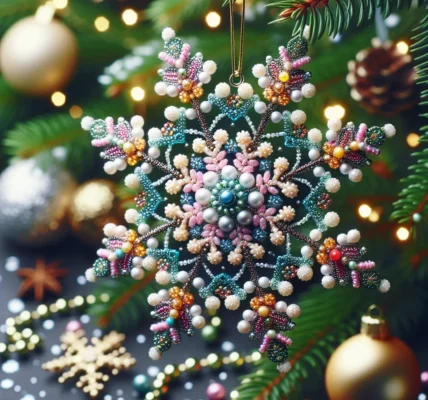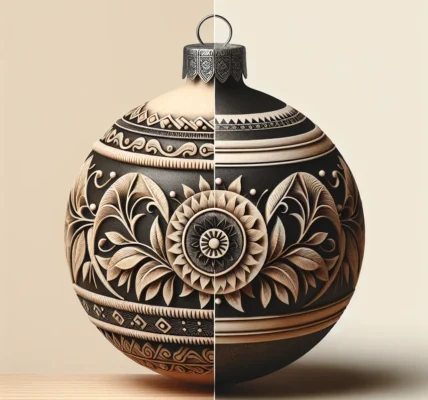The Origins of Christmas Baubles: A Historical Perspective
When it comes to the festive decorations adorning Christmas trees, the bauble holds a special place in the hearts of many. With its origins dating back to 16th century Germany, the Christmas bauble has evolved into an iconic symbol of the holiday season. Originally, these decorations were crafted from glass and were painstakingly hand-blown by artisans. The first baubles were inspired by fruits such as apples, which were hung on trees during the winter solstice festival as a symbol of the paradise tree in medieval mystery plays.
As time progressed, the glassblowers of Lauscha, Germany, began creating glass ornaments in the shape of fruits, nuts, and other symbols of abundance and fertility. These early decorations were not just reserved for Christmas trees but were also used to adorn the branches of the “paradise tree” during the festive season. It wasn’t until the 19th century that the popularity of Christmas baubles soared, thanks to the industrial revolution which made mass production possible. The intricate craftsmanship of the glassblowers and their exquisite designs captivated people around the world, propelling the bauble into the spotlight as one of the most beloved Christmas decorations.
Today, Christmas baubles come in an array of materials, shapes, and designs, reflecting a fusion of tradition and modern innovation. From delicate glass ornaments to handcrafted wooden baubles, the tradition of adorning Christmas trees with these timeless decorations continues to endure, transcending generations and bringing joy to people across the globe.
The Evolution of Christmas Baubles: From Tradition to Trend
Christmas baubles, also known as Christmas ornaments, have a rich history and deep symbolism. These decorative items have evolved over the years, transitioning from traditional symbols to trendy expressions of holiday spirit.
The tradition of decorating Christmas trees with baubles dates back to the 16th century in Germany, where they were initially crafted from glass, metal, or wood. The early designs were often intricate and symbolized various aspects of the Christmas story, such as angels, stars, and nativity scenes.
As time passed, the popularity of Christmas baubles spread across Europe and beyond. Their designs began to reflect the artistic styles of different regions, incorporating unique colors, patterns, and materials. The Victorian era saw the rise of delicate, hand-blown glass baubles, which became highly sought after and cherished heirlooms.
In the modern era, Christmas baubles have experienced a renaissance as a prominent element of holiday decor. Contemporary designs range from traditional motifs to innovative concepts that resonate with diverse cultural and artistic influences. With the advent of mass production, a wide array of materials, including plastic, fabric, and even recycled materials, are now used to create baubles, reflecting a growing emphasis on sustainability and creativity.
Moreover, the evolution of Christmas baubles has integrated technological advancements, leading to the development of illuminated and interactive ornaments that captivate audiences of all ages. In today’s digital age, it is not uncommon to find LED-lit baubles or personalized baubles featuring QR codes that link to multimedia content, adding an engaging and personalized touch to the holiday decorating experience.
Overall, the evolution of Christmas baubles from traditional symbols to trendy expressions showcases their enduring significance in the celebration of the holiday season. As these ornaments continue to evolve, they remain a cherished and vibrant representation of the joy and creativity that define the spirit of Christmas.
Symbolism in Christmas Baubles: Uncovering Their Meaning
Christmas baubles, also known as Christmas ornaments, have been a traditional part of Christmas decorations for centuries. Beyond their aesthetic appeal, these baubles carry deep symbolism that reflects the spirit and traditions of the holiday season. Uncovering the meaning behind these ornaments reveals a rich tapestry of cultural, religious, and historical significance.
The tradition of decorating trees with baubles dates back to 16th-century Germany, where people adorned evergreen trees with apples as a symbol of the Garden of Eden during Christmas celebrations. Over time, this tradition evolved, and the apples were replaced with various ornaments, including the round, colorful baubles we are familiar with today.
Symbolism in Christmas baubles extends beyond mere decoration. The spherical shape of the baubles is often associated with unity, completeness, and the eternal nature of the soul. In some cultures, the reflective surface of the baubles is believed to ward off evil spirits, bringing protection and good luck to the household.
Furthermore, the colors of the baubles carry specific meanings. Red is often associated with love and the sacrifice of Jesus, while gold symbolizes wealth, prosperity, and the light of the sun. Green reflects nature and rebirth, while silver signifies purity and redemption.
Religious symbols such as angels, nativity scenes, and stars are frequently depicted on Christmas baubles, emphasizing the Christian significance of the holiday. Additionally, non-religious symbols like snowflakes, reindeer, and Santa Claus also add to the diverse symbolism associated with these ornaments.
In conclusion, Christmas baubles are not just decorative items; they are powerful symbols that encapsulate the essence of Christmas. Their history and symbolism reflect the cultural diversity and the deeper spiritual meanings that have enriched the tradition of Christmas celebrations for centuries.
The Cultural Significance of Christmas Baubles: A Visual Exploration
Christmas baubles, also known as Christmas ornaments, have a rich cultural significance that spans centuries. These decorative objects have become an integral part of Christmas traditions around the world, symbolizing the festive spirit and bringing joy and beauty to homes during the holiday season.
Originally, Christmas baubles were a symbol of wealth and prosperity, often crafted from precious materials such as blown glass, silver, and gold. Their use as decorations during the Christmas season can be traced back to 16th century Germany, where they were initially fashioned in the shape of fruits, nuts, and other symbols of abundance. Over time, their significance evolved to represent the fruits of the Tree of Paradise in the Christmas Eve plays and eventually became associated with the festive Christmas tree.
Christmas baubles are not only a reflection of cultural and historical traditions but also serve as a visual representation of the spirit of Christmas. Their vibrant colors, intricate designs, and shimmering surfaces capture the essence of the holiday season, evoking feelings of warmth, nostalgia, and togetherness. The act of adorning the Christmas tree with baubles has become a cherished ritual for many families, symbolizing unity and celebration.
As Christmas traditions have spread across the globe, the cultural significance of baubles has adapted to different regions, incorporating diverse symbols and motifs that reflect local customs and beliefs. From traditional red and green baubles in Western cultures to intricately crafted hand-painted baubles in Eastern traditions, these decorations serve as a visual testament to the diversity of Christmas celebrations worldwide.
In conclusion, Christmas baubles hold a profound cultural significance, representing the timeless traditions and visual splendor of the holiday season. Their symbolism transcends borders and unites people in the joyous spirit of Christmas, making them a cherished and essential part of festive decorations in homes everywhere.




